Design of a Passive Silicon-on-Insulator-Based On-Chip Optical Circulating Network Supporting Mode Conversion and High Optical Isolation
Abstract
:1. Introduction
2. Proposed Optical Circulating Network Architecture
3. Demonstration, Results, and Discussion
4. Conclusions
Author Contributions
Funding
Institutional Review Board Statement
Informed Consent Statement
Data Availability Statement
Conflicts of Interest
References
- Soref, R. The Past, Present, and Future of Silicon Photonics. IEEE J. Sel. Top. Quantum Electron. 2006, 12, 1678–1687. [Google Scholar] [CrossRef]
- Jalali, B.; Fathpour, S. Silicon Photonics. J. Lightw. Technol. 2006, 24, 4600–4615. [Google Scholar] [CrossRef]
- Dai, D.; Liang, D.; Cheben, P. Next-generation silicon photonics: Introduction. Photon Res. 2022, 10, NGSP1–NGSP3. [Google Scholar] [CrossRef]
- Tsang, H.K.; Liu, Y. Nonlinear optical properties of silicon waveguides. Semicond. Sci. Technol. 2008, 23, 064007. [Google Scholar] [CrossRef]
- Tsang, H.K.; Chen, X.; Cheng, Z.; Zhou, W.; Tong, Y. Subwavelength Silicon Photonics. In Silicon Photonics IV: Innovative Frontiers; Topics in Applied Physics; Springer: Cham, Switzerland, 2021; Volume 139, pp. 565–572. [Google Scholar]
- Shahbaz, M.; Butt, M.A.; Piramidowicz, R. Breakthrough in Silicon Photonics Technology in Telecommunications. Bio-sensing, and Gas Sensing. Micromachines 2023, 14, 1637. [Google Scholar] [CrossRef]
- Hashemi, H. A Review of Silicon Photonics LiDAR. In Proceedings of the 2022 IEEE Custom Integrated Circuits Conference (CICC), Newport Beach, CA, USA, 21–24 April 2024; pp. 1–8. [Google Scholar]
- de Lima, T.F.; Shastri, B.J.; Tait, A.N.; Nahmias, M.A.; Prucnal, P.R. Progress in neuromorphic photonics. Nanophotonics 2017, 6, 577–599. [Google Scholar] [CrossRef]
- Sajan, S.C.; Singh, A.; Sharma, P.K.; Kumar, S. Silicon Photonics Biosensors for Cancer Cells Detection—A Review. IEEE Sensors J. 2023, 23, 3366–3377. [Google Scholar] [CrossRef]
- Siew, S.Y.; Li, B.; Gao, F.; Zheng, H.Y.; Zhang, W.; Guo, P.; Xie, S.W.; Song, A.; Dong, B.; Luo, L.W.; et al. Review of Silicon Photonics Technology and Platform Development. J. Light. Technol. 2021, 39, 4374–4389. [Google Scholar] [CrossRef]
- Li, C.; Dai, D. Compact polarization beam splitter for silicon photonic integrated circuits with a 340-nm-thick silicon core layer. Opt. Lett. 2017, 42, 4243–4246. [Google Scholar] [CrossRef]
- Dai, D.; Wang, J.; Shi, Y. Silicon mode (de)multiplexer enabling high capacity photonic networks-on-chip with a sin-gle-wavelength-carrier light. Opt. Lett. 2013, 38, 1422–1424. [Google Scholar] [CrossRef]
- Li, C.-L.; Jiang, X.-H.; Hsu, Y.; Chen, G.-H.; Chow, C.-W.; Dai, D.-X. Ten-channel mode-division-multiplexed silicon photonic integrated circuit with sharp bends. Front. Inf. Technol. Electron. Eng. 2019, 20, 498–506. [Google Scholar] [CrossRef]
- Stern, B.; Zhu, X.; Chen, C.P.; Tzuang, L.D.; Cardenas, J.; Bergman, K.; Lipson, M. On-chip mode-division multiplexing switch. Optica 2015, 2, 530–535. [Google Scholar] [CrossRef]
- Hsu, Y.; Chuang, C.-Y.; Wu, X.; Chen, G.-H.; Hsu, C.-W.; Chang, Y.-C.; Chow, C.-W.; Chenb, J.; Lai, Y.-C.; Yeh, C.-H.; et al. 2.6 Tbit/s On-Chip Optical Interconnect Supporting Mode-Division-Multiplexing and PAM-4 Signal. IEEE Photon-Technol. Lett. 2018, 30, 1052–1055. [Google Scholar] [CrossRef]
- Chen, G.-H.; Tsai, J.-F.; Peng, C.-W.; Kuo, P.-C.; Chen, C.-J.; Chow, C.-W.; Yeh, C.-H.; Lai, Y.; Liu, Y. Compact Mode Division MUX/DEMUX Using Enhanced Evanescent-Wave Coupling on Silicon-on-Insulator (SOI) Platform for 11-Tbit/s Broadband Transmission. IEEE Access 2020, 8, 219881–219890. [Google Scholar] [CrossRef]
- Liu, Y.; Wang, X.; Yao, Y.; Du, J.; Song, Q.; Xu, K. Silicon photonic arrayed waveguide grating with 64 channels for the 2 µm spectral range. Opt. Lett. 2022, 47, 1186–1189. [Google Scholar] [CrossRef]
- Liu, S.; Hu, H.; Ma, X.; Dong, R.; Fang, Q.; Chen, H. Low-crosstalk silicon-photonics arrayed waveguide gratings integrated with micro-ring filter. Front. Phys. 2022, 10, 1018589. [Google Scholar] [CrossRef]
- Liu, J.; Li, S.; Ding, Y.; Chen, S.; Du, C.; Mo, Q.; Morioka, T.; Yvind, K.; Oxenløwe, L.K.; Yu, S.; et al. Orbital angular momentum modes emission from a silicon photonic integrated device for km-scale data-carrying fiber transmission. Opt. Express 2018, 26, 15471–15479. [Google Scholar] [CrossRef]
- Jian, Y.H.; Chow, C.W. Design and analysis of a compact micro-ring resonator signal emitter to reduce the uniformi-ty-induced phase distortion and crosstalk in orbital angular momentum (OAM) division multiplexing. Opt. Exp. 2023, 31, 810–825. [Google Scholar] [CrossRef]
- Stepanov, I.V.; Fatkhiev, D.M.; Lyubopytov, V.S.; Kutluyarov, R.V.; Grakhova, E.P.; Neumann, N.; Khonina, S.N.; Sultanov, A.K. Wavelength-Tunable Vortex Beam Emitter Based on Silicon Micro-Ring with PN Depletion Diode. Sensors 2022, 22, 929. [Google Scholar] [CrossRef]
- Lin, Y.-Z.; Chow, C.-W.; Yu, T.-W.; Jian, Y.-H.; Hung, T.-Y.; Chen, J.-W.; Yeh, C.-H. Flexible Data Rate Allocation Using Non-Orthogonal Multiple Access (NOMA) in a Mode Division Multiplexing (MDM) Optical Power Splitter for System-on-Chip Networks. Sensors 2023, 23, 7259. [Google Scholar] [CrossRef]
- Fujii, Y. High-isolation polarization-independent optical circulator. J. Light. Technol. 1991, 9, 1238–1243. [Google Scholar] [CrossRef]
- Mitsuya, K.; Shoji, Y.; Mizumoto, T. Demonstration of a Silicon Waveguide Optical Circulator. IEEE Photon-Technol. Lett. 2013, 25, 721–723. [Google Scholar] [CrossRef]
- Jalas, D.; Petrov, A.Y.; Eich, M. Optical three-port circulators made with ring resonators. Opt. Lett. 2014, 39, 1425–1428. [Google Scholar] [CrossRef]
- Liu, L.; Dong, J.; Gao, D.; Zheng, A.; Zhang, X. On-chip passive three-port circuit of all-optical ordered-route transmission. Sci. Rep. 2015, 5, 10190. [Google Scholar] [CrossRef]
- Wang, Q.; Ouyang, Z.; Tao, K.; Lin, M.; Ruan, S. T-shaped optical circulator based on coupled magneto-optical rods and a side-coupled cavity in a square-lattice photonic crystal. Phys. Lett. A 2012, 376, 646–649. [Google Scholar] [CrossRef]
- Śmigaj, W.; Romero-Vivas, J.; Gralak, B.; Magdenko, L.; Dagens, B.; Vanwolleghem, M. Magneto-optical circulator designed for operation in a uniform external magnetic field. Opt. Lett. 2010, 35, 568–570. [Google Scholar] [CrossRef]
- Richardson, D.J.; Fini, J.M.; Nelson, L.E. Space-division multiplexing in optical fibres. Nat. Photonics 2013, 7, 354–362. [Google Scholar] [CrossRef]
- Kuo, P.-C.; Tong, Y.; Chow, C.-W.; Tsai, J.-F.; Liu, Y.; Chang, Y.-C.; Yeh, C.H.; Tsang, H.K. 4.36 Tbit/s Silicon Chip-to-Chip Transmission via Few-Mode Fiber (FMF) using 2D Sub-wavelength Grating Couplers. In Proceedings of the Optical Fiber Communications Conference and Exhibition, OFC 2021, San Francisco, CA, USA, 6–10 June 2021; p. M3D.6. [Google Scholar]
- Weng, Y.; Ip, E.; Pan, Z.; Wang, T. Advanced spatial-division multiplexed measurement systems propositions—From telecommunication to sensing applications: A review. Sensors 2016, 16, 1387. [Google Scholar] [CrossRef]
- Kawaguchi, Y.; Tsutsumi, K. Mode multiplexing and demultiplexing devices using multimode Interference couplers. Electron. Lett. 2002, 38, 1701–1702. [Google Scholar] [CrossRef]
- Soldano, L.B.; Pennings, E.C.M. Optical multi-mode interference devices based on self-imaging: Principles and applica-tions. J. Lightw. Technol. 1995, 13, 615–627. [Google Scholar] [CrossRef]
- Johnson, M.; Thompson, M.G.; Sahin, D. Low-loss, low-crosstalk waveguide crossing for scalable integrated silicon pho-tonics applications. Opt. Exp. 2020, 28, 12498–12507. [Google Scholar] [CrossRef]
- Hu, W.; Sarveswaran, K.; Lieberman, M.; Bernstein, G.H. Sub-10 nm electron beam lithography using cold development of poly(methylmethacrylate). J. Vac. Sci. Technol. B Microelectron. Nanometer Struct. 2004, 22, 1711–1716. [Google Scholar] [CrossRef]
- Lin, S.; Hammood, M.; Yun, H.; Luan, E.; Jaeger, N.; Chrostowski, L. Computational lithography for silicon photonics de-sign. IEEE J. Sel. Top. Quantum Electron. 2020, 26, 8201408. [Google Scholar] [CrossRef]
- Lv, D.; Wu, L.; Liu, C.; Li, A.; Wang, R.; Wu, A. Broadband and Low-Loss Silicon Photonic Directional Coupler for Signal Power Tapping on the 3 μm SOI Waveguide Platform. Photonics 2023, 10, 776. [Google Scholar] [CrossRef]
- Li, C.; Zhang, M.; Xu, H.; Tan, Y.; Shi, Y.; Dai, D. Subwavelength silicon photonics for on-chip mode-manipulation. PhotoniX 2021, 2, 11. [Google Scholar] [CrossRef]
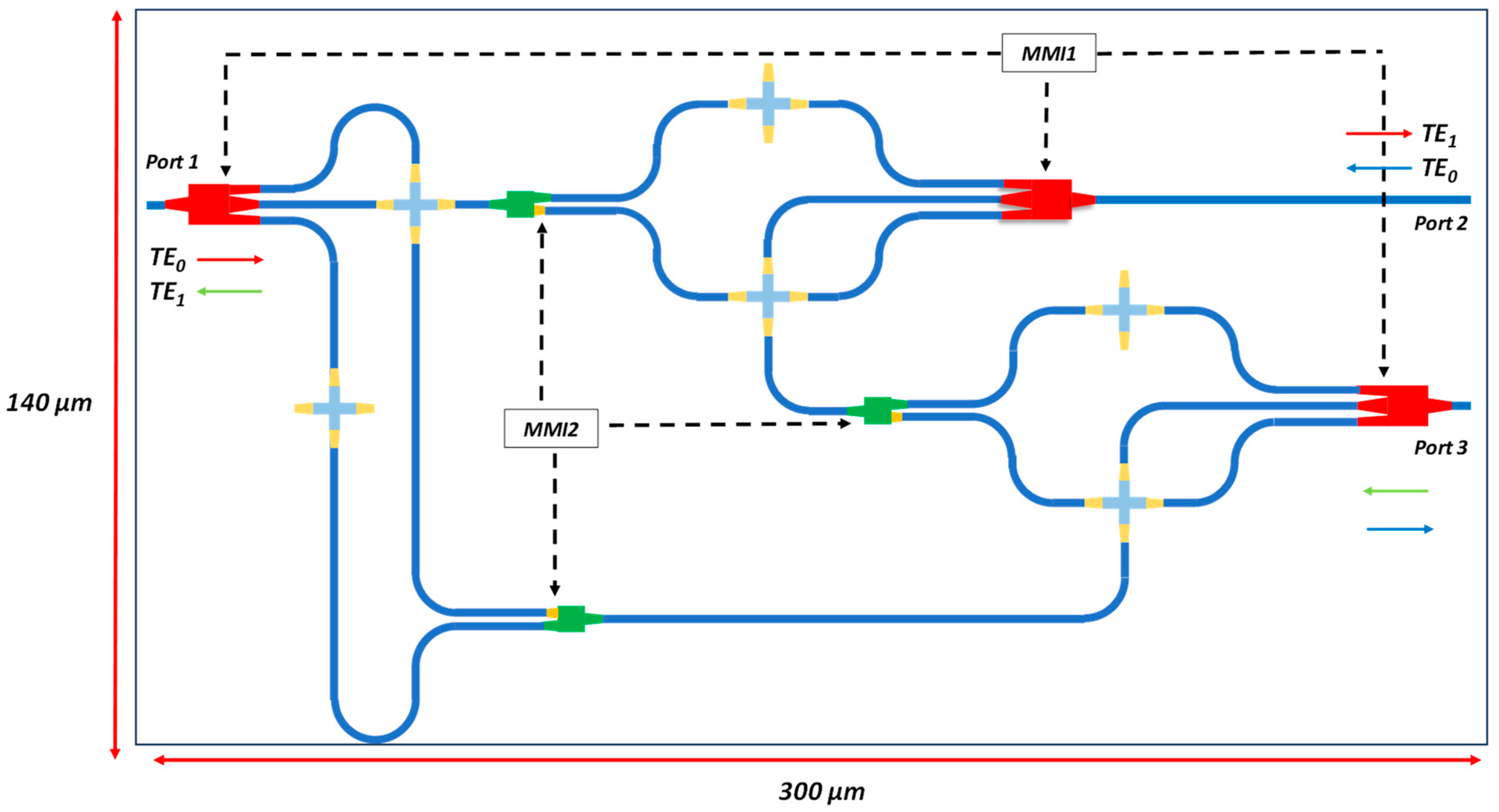
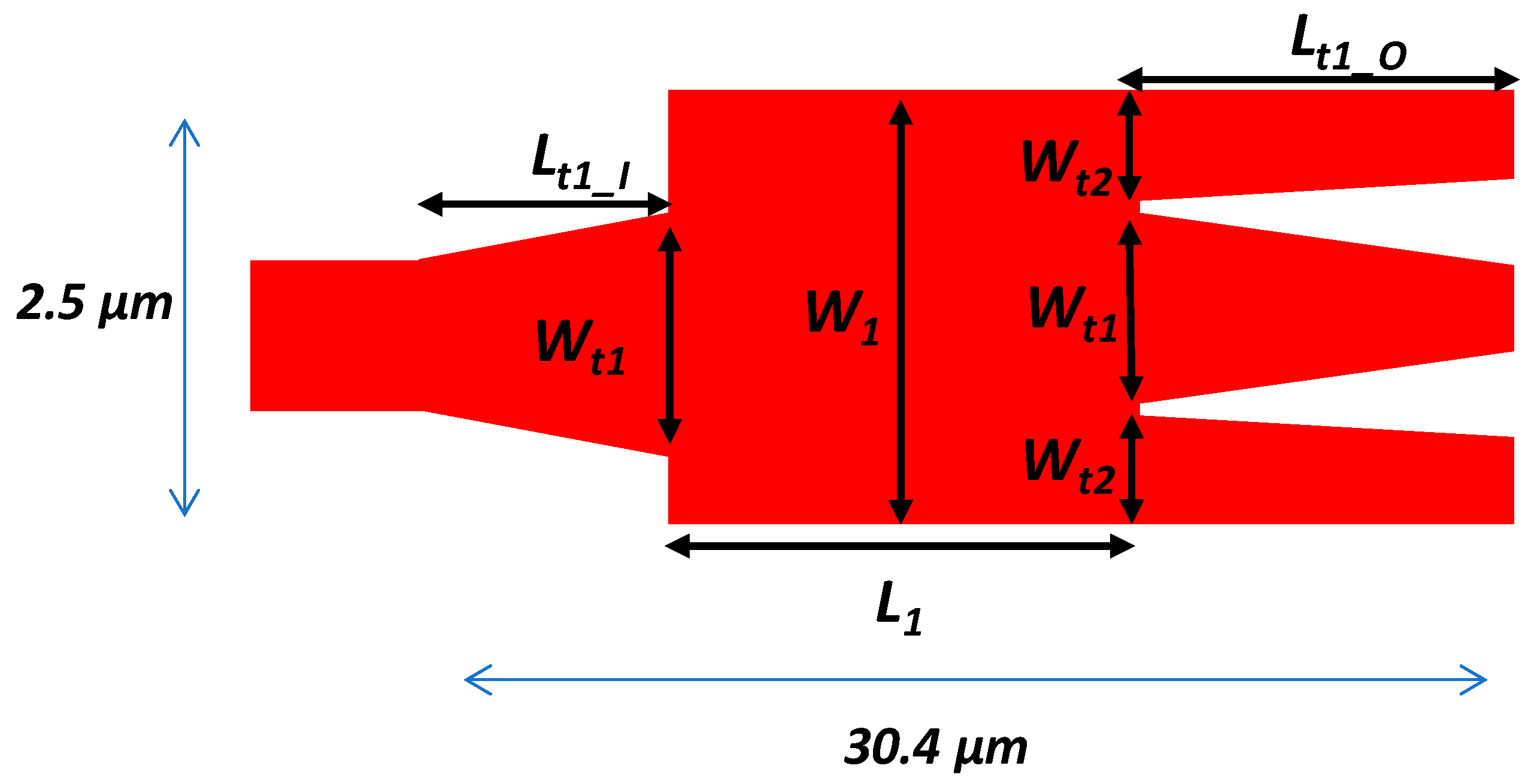
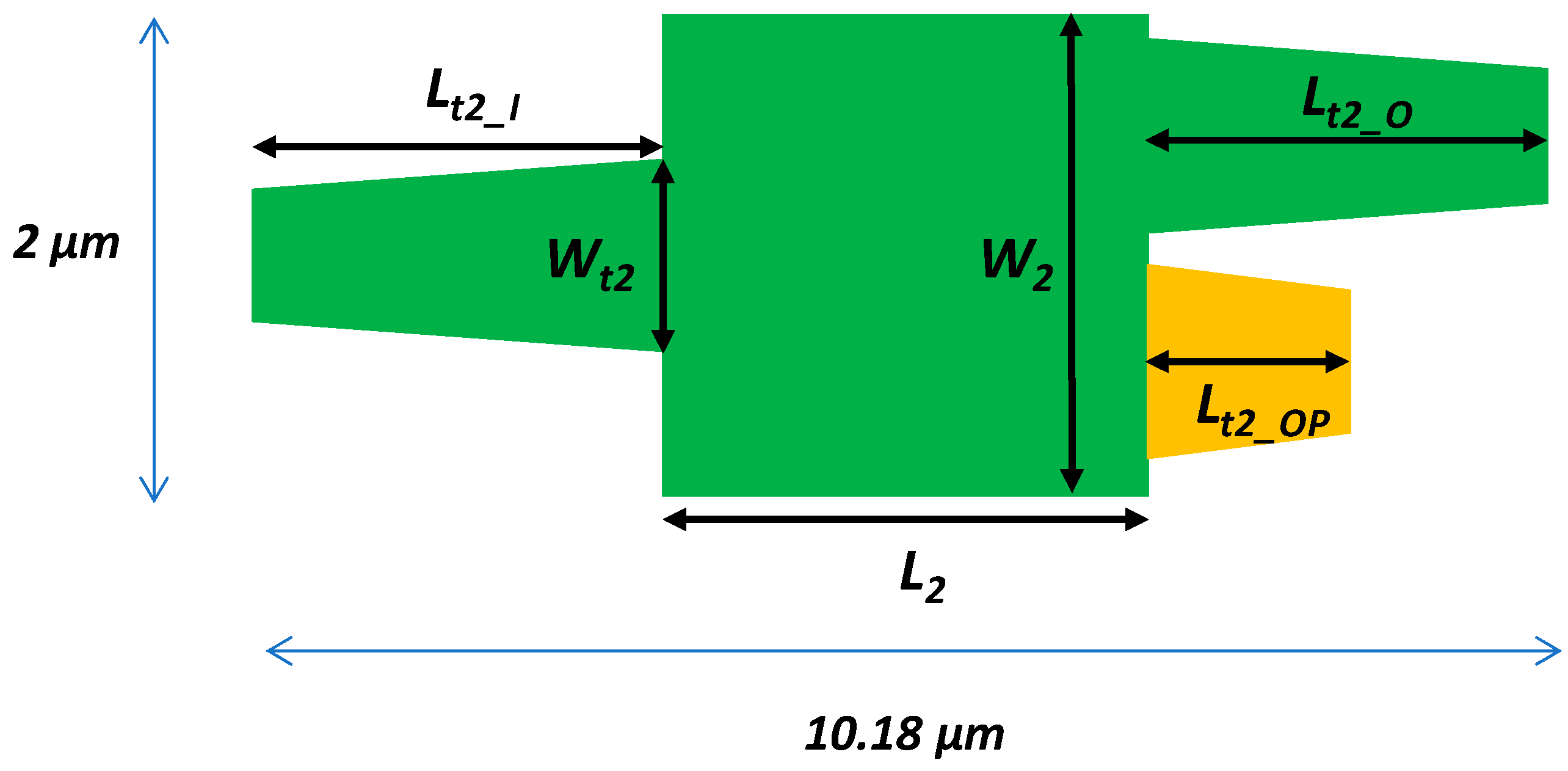
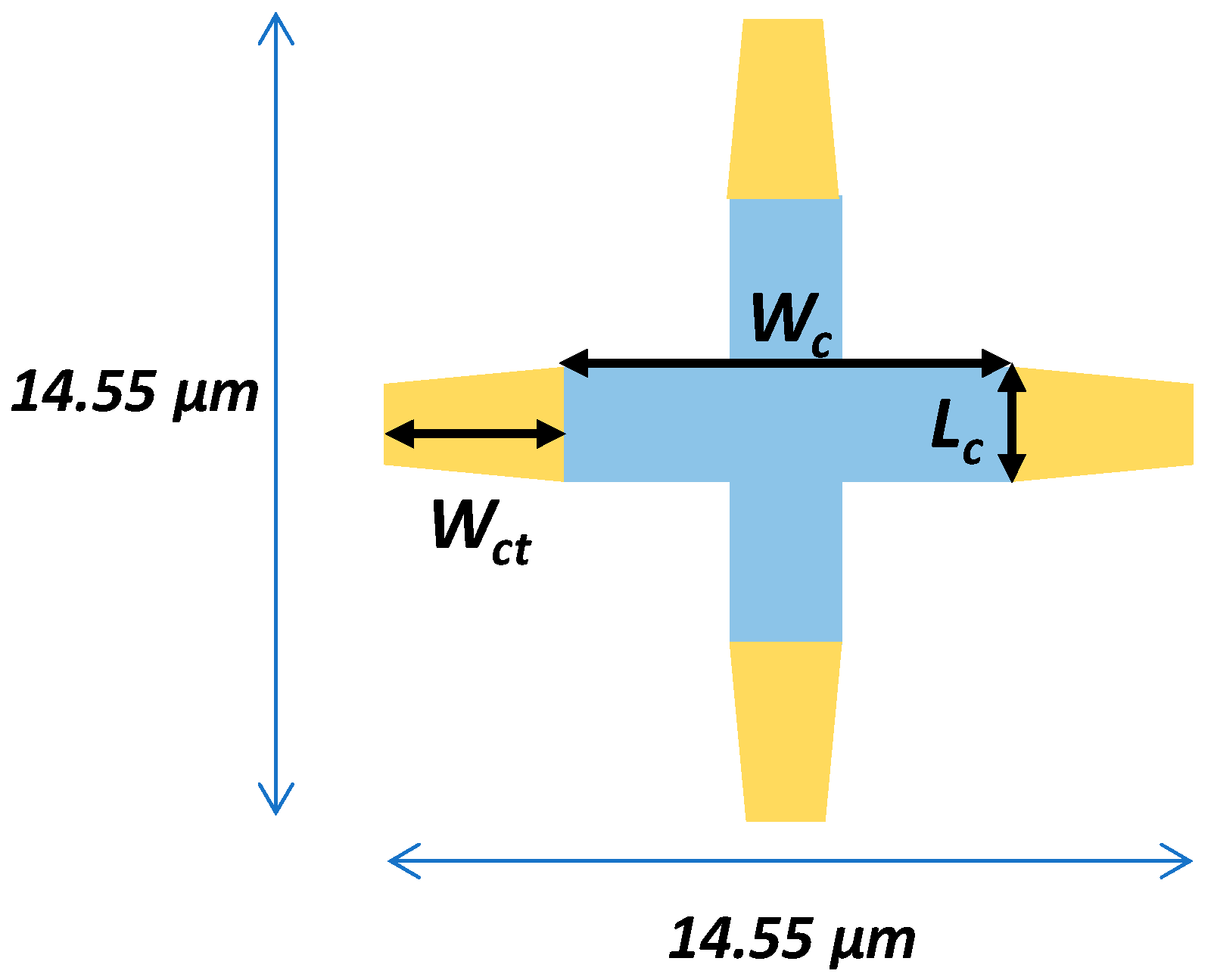
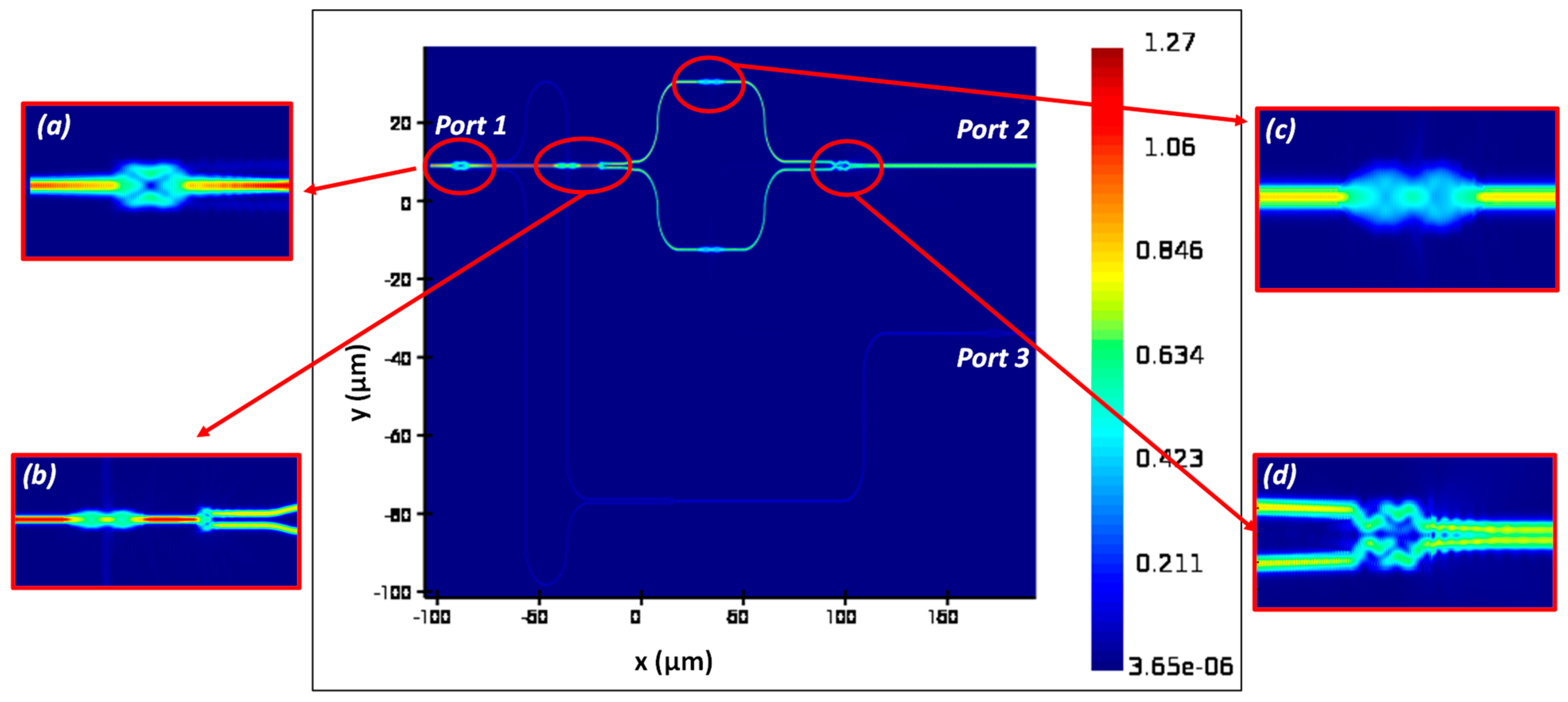
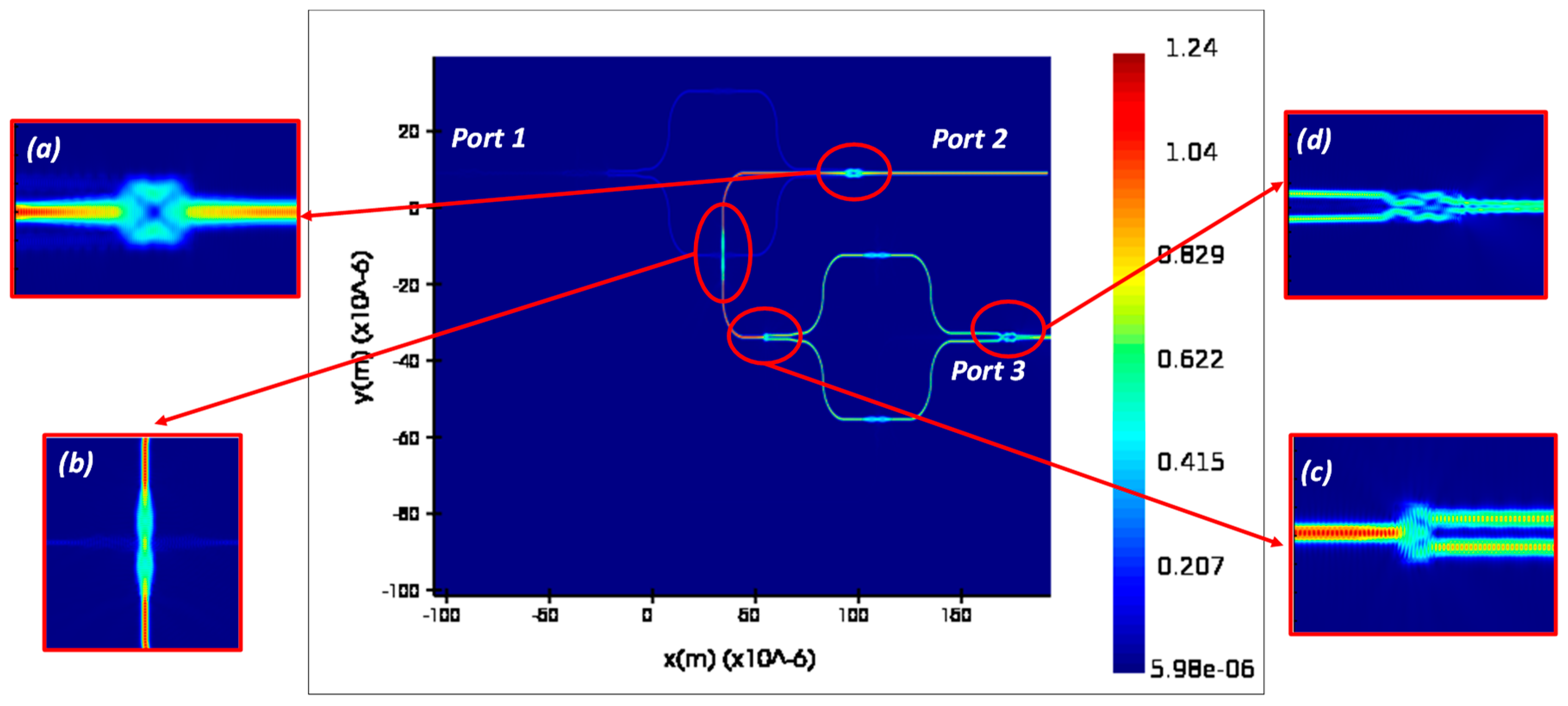


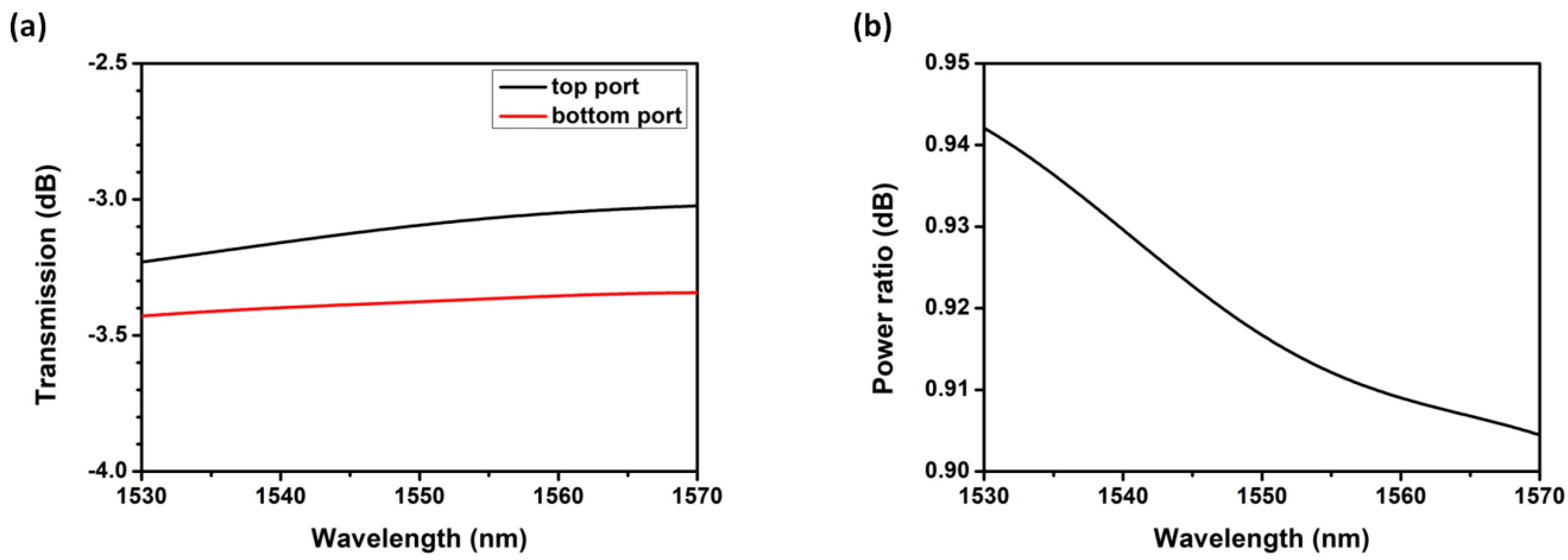


Disclaimer/Publisher’s Note: The statements, opinions and data contained in all publications are solely those of the individual author(s) and contributor(s) and not of MDPI and/or the editor(s). MDPI and/or the editor(s) disclaim responsibility for any injury to people or property resulting from any ideas, methods, instructions or products referred to in the content. |
© 2023 by the authors. Licensee MDPI, Basel, Switzerland. This article is an open access article distributed under the terms and conditions of the Creative Commons Attribution (CC BY) license (https://creativecommons.org/licenses/by/4.0/).
Share and Cite
Lin, Y.-Z.; Chen, J.-W.; Chow, C.-W.; Yeh, C.-H. Design of a Passive Silicon-on-Insulator-Based On-Chip Optical Circulating Network Supporting Mode Conversion and High Optical Isolation. Photonics 2023, 10, 1278. https://doi.org/10.3390/photonics10111278
Lin Y-Z, Chen J-W, Chow C-W, Yeh C-H. Design of a Passive Silicon-on-Insulator-Based On-Chip Optical Circulating Network Supporting Mode Conversion and High Optical Isolation. Photonics. 2023; 10(11):1278. https://doi.org/10.3390/photonics10111278
Chicago/Turabian StyleLin, Yuan-Zeng, Jian-Wen Chen, Chi-Wai Chow, and Chien-Hung Yeh. 2023. "Design of a Passive Silicon-on-Insulator-Based On-Chip Optical Circulating Network Supporting Mode Conversion and High Optical Isolation" Photonics 10, no. 11: 1278. https://doi.org/10.3390/photonics10111278
APA StyleLin, Y.-Z., Chen, J.-W., Chow, C.-W., & Yeh, C.-H. (2023). Design of a Passive Silicon-on-Insulator-Based On-Chip Optical Circulating Network Supporting Mode Conversion and High Optical Isolation. Photonics, 10(11), 1278. https://doi.org/10.3390/photonics10111278






